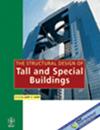Shear capacity and lateral stiffness of composite plate shear walls‐concrete encased under cyclic loading
IF 1.3
3区 工程技术
Q3 CONSTRUCTION & BUILDING TECHNOLOGY
引用次数: 1
Abstract
Composite plate shear walls‐concrete encased (C‐PSW/CE), consisting of the steel plates and concrete encasements on one or both sides of the plate, are an excellent lateral force resisting system. This paper theoretically and numerically reveals the shear resisting mechanism of C‐PSW/CE under cyclic loading. The steel web resists the lateral force through in‐plane shear before buckling, and the concrete encasements resist lateral force by diagonal compression field action. As the displacement increases, the shear force ratio of the steel web plate increases before yielding in shear and that of concrete encasements reduces. The shear force ratios of the steel web plate and concrete encasements remain essentially constant after yielding of the steel web. Considering the shear contribution of the concrete encasements, the formula is proposed to evaluate the shear capacity of C‐PSW/CE. Based on the principle of virtual work, the equation is proposed to predict the lateral stiffness of C‐PSW/CE under cyclic loading, accounting for the concrete deterioration due to cyclic effect.循环荷载作用下复合板剪力墙-混凝土的抗剪能力和侧移刚度
复合板剪力墙-混凝土包裹(C‐PSW/CE),由钢板和板一侧或两侧的混凝土包裹组成,是一种出色的抗侧向力系统。本文从理论和数值上揭示了C‐PSW/CE在循环荷载作用下的抗剪机理。钢腹板在屈曲前通过平面内剪切抵抗侧向力,混凝土围护结构通过对角压缩场作用抵抗侧向力。随着位移的增加,钢腹板在剪切屈服前的剪力比增加,混凝土围护结构的剪力比减小。钢腹板和混凝土包壳的剪切力比在钢腹板屈服后基本保持恒定。考虑到混凝土围护结构的抗剪贡献,提出了评估C‐PSW/CE抗剪承载力的公式。基于虚功原理,提出了考虑循环效应引起混凝土劣化的C‐PSW/CE在循环荷载作用下的横向刚度预测方程。
本文章由计算机程序翻译,如有差异,请以英文原文为准。
求助全文
约1分钟内获得全文
求助全文
来源期刊
CiteScore
5.30
自引率
4.20%
发文量
83
审稿时长
6-12 weeks
期刊介绍:
The Structural Design of Tall and Special Buildings provides structural engineers and contractors with a detailed written presentation of innovative structural engineering and construction practices for tall and special buildings. It also presents applied research on new materials or analysis methods that can directly benefit structural engineers involved in the design of tall and special buildings. The editor''s policy is to maintain a reasonable balance between papers from design engineers and from research workers so that the Journal will be useful to both groups. The problems in this field and their solutions are international in character and require a knowledge of several traditional disciplines and the Journal will reflect this.
The main subject of the Journal is the structural design and construction of tall and special buildings. The basic definition of a tall building, in the context of the Journal audience, is a structure that is equal to or greater than 50 meters (165 feet) in height, or 14 stories or greater. A special building is one with unique architectural or structural characteristics.
However, manuscripts dealing with chimneys, water towers, silos, cooling towers, and pools will generally not be considered for review. The journal will present papers on new innovative structural systems, materials and methods of analysis.

 求助内容:
求助内容: 应助结果提醒方式:
应助结果提醒方式:


